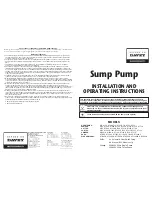
Manual 2100-583G
Page
46 of 48
BOTH HIGH & LOW SIDE OF HIGH AND LOW SIDE OF
THE SCROLL COMPRESSOR MUST BE CHECKED WITH
MANIFOLD GAUGES BEFORE UNBRAZING SYSTEM
COMPONENTS. FAILURE TO DO SO COULD CAUSE
PRESSURIZED REFRIGERANT AND OIL MIXTURE TO IGNITE
IF IT ESCAPES AND CONTACTS THE BRAZING FLAME
CAUSING PROPERTY DAMAGE, BODILY HARM, OR DEATH.
SERVICE HINTS
Check all power fuses or circuit breakers to ensure that
they are all the correct rating.
UNBRAZING SYSTEM COMPONENTS
If the refrigerant charge is removed from a scroll equipped
unit by bleeding the high side only, it is sometimes
possible for the scrolls to seal, preventing pressure
equalization through the compressor. This may leave
low side shell and suction line tubing pressurized. If the
brazing torch is then applied to the low side while the low
side shell and suction line contain pressure, the pressurized
refrigerant and oil mixture could ignite when it escapes
and contacts the brazing flame. To prevent this occurence,
it is important to check both the high and low side
system pressures with manifold gauges before unbrazing.
Removal of service port cores is highly recommended
as secondary insurance that all system pressure has been
relieved.
SERVICE
COMPRESSOR SOLENOID
See Sequence of Operation on Pages 28 & 29 for function.
A nominal 24-volt direct current coil activates the internal
compressor solenoid. The input control circuit voltage
must be 18 to 28 volts ac. The coil power requirements
is 5 VA. The external electrical connection is made with
a molded plug assembly. This plug contains a full wave
rectifier to supply direct current (dc volts) to the unloader
coil.
COMPRESSOR SOLENOID TEST PROCEDURE
– If it is suspected that the unloader is not working, the
following methods may be used to verify operation.
1. Operate the system and measure compressor
amperage. Cycle the compressor solenoid on
and off at 10-second intervals. The compressor
amperage should go up or down at least 25 percent.
2. If Step #1 does not give the expected results, shut
unit off. Apply 18 to 28 volts ac to the solenoid
molded plug leads and listen for a click as the
solenoid pulls in. Remove power and listen for
another click as the solenoid returns to its original
position.
3. If “clicks” cannot be heard, shut off power and
remove the control circuit molded plug from
the compressor and measure the solenoid coil
resistance. The resistance should be 32 to 60 ohms
depending on compressor temperature.
4. Next, check the molded plug:
Voltage Check:
Apply control voltage to the
plug wires (18 to 28 volts ac). The measured
dc voltage at the female connectors in the plug
should be around 15 to 27 volt dc.
Resistance Check:
Measure the resistance from
the end of the one molded plug lead to either of
the two female connectors in the plug. One of the
connectors should read close to zero ohms, while
the other should read infinity. Repeat with other
wire. The same female connector as before should
read zero, while the other connector again reads
infinity. Reverse polarity on the ohmmeter leads
and repeat. The female connector that read infinity
previously should now read close to zero ohms.
Replace plug if either of these test methods does
not show the desired results.



































